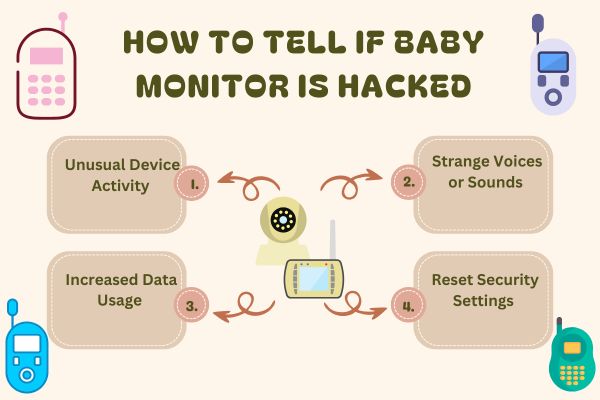Parents find that baby monitors are invaluable because they give them peace of mind by enabling them to watch their children from a distance. But as connectivity has increased, hackers have turned their attention to these gadgets. Protecting your baby’s privacy requires knowing how to secure your baby monitor and how to determine whether it has been compromised. This tutorial describes the many kinds of baby monitors, their definition, and how to tell if baby monitor is hacked ?
You may want to read: Are Baby Monitors Necessary?
What Is a Baby Monitor?

An electronic gadget called a baby monitor assists parents in keeping an eye on their infant’s activities, frequently from a different room. Usually, these monitors are made up of two parts: a transmitter that is kept in the infant’s room and a receiver that the parent carries. Advanced functions like temperature tracking, two-way communication, video streaming, and even lullabies are included in modern baby monitors.
Despite their extreme convenience, many gadgets—especially internet-connected models—can be hacked if they are not well secured. In this tutorial we will explore: how to tell if baby monitor is hacked ?
Types of Baby Monitors

Understanding the different types of baby monitors can help you choose the right one for your needs and assess its potential security risks.
1. Analog Baby Monitors
These are older models that transmit audio signals using radio frequencies. While affordable, they are less secure because their signals can be easily intercepted by nearby devices.
2. Digital Baby Monitors
Digital monitors offer encrypted transmissions, making them more secure than analog ones. They provide clearer audio and video quality, reducing interference from other devices.
3. Wi-Fi Baby Monitors
Wi-Fi monitors connect to your home internet and allow you to stream video or audio through your smartphone or computer. However, a Wi-Fi baby monitor hacked is a frequent concern due to potential vulnerabilities in network security.
4. Non-Wi-Fi Baby Monitors
These monitors do not connect to the internet, making them less susceptible to hacking. However, can non Wi-Fi baby monitors be hacked? Yes, but it requires physical proximity and specialized equipment.
5. FHSS Baby Monitors
Frequency-Hopping Spread Spectrum (FHSS) monitors enhance security by rapidly changing frequencies during transmission, preventing signal interception by hackers.
6. Smart Baby Monitors
Smart monitors often come equipped with AI features, such as sleep tracking, breathing monitoring, and motion detection. While innovative, their advanced connectivity makes them potential targets for hackers if not properly secured.
How to Tell If Baby Monitor Is Hacked

To protect your baby’s privacy, watch for the following signs that may indicate your baby monitor is hacked:
1. Unusual Device Activity
If the monitor’s camera moves unexpectedly, turns on/off by itself, or shows settings changes you didn’t make, it could be compromised.
2. Strange Voices or Sounds
Hearing unfamiliar voices or noises, particularly in models with two-way communication, is a clear sign of unauthorized access.
3. Unexpected Network Behavior
Check your Wi-Fi network for unfamiliar devices. A hacker must be on your network to access your baby monitor.
4. Increased Data Usage
If your internet usage spikes unexpectedly, your baby monitor may be streaming data to an unauthorized user.
5. Reset Security Settings
A reset to default passwords or settings without your input indicates potential tampering by a hacker.
Steps to Secure Your Baby Monitor

Here’s how you can secure your baby monitor and prevent it from being hacked:
1. Change Default Passwords
Always replace the default password with a strong, unique combination of letters, numbers, and symbols.
2. Update Firmware Regularly
Check for updates and install them promptly to fix potential vulnerabilities in your device’s software.
3. Use Two-Factor Authentication (2FA)
Enable 2FA if supported. This adds an additional layer of security by requiring a verification code along with your password.
4. Secure Your Wi-Fi Network
- Use a strong password for your Wi-Fi.
- Enable WPA3 encryption for enhanced protection.
- Create a separate network for IoT devices like baby monitors.
5. Turn Off Remote Access Features
Disable remote access if you don’t need it. This reduces the risk of unauthorized users connecting to your monitor.
6. Opt for Secure Models
Invest in a baby monitor with built-in encryption and FHSS technology for maximum security.
What to Do If You Suspect Hacking

If you suspect your baby monitor is hacked, follow these steps immediately:
- Disconnect the monitor from your Wi-Fi network.
- Change passwords for both the device and your Wi-Fi router.
- Update the monitor’s firmware.
- Monitor your Wi-Fi for unknown devices and remove any unauthorized connections.
- Contact the manufacturer for further assistance.
Protect Your Baby and Gain Peace of Mind
You should never compromise your baby’s privacy or safety. You may enjoy the ease of keeping an eye on your child without worrying about cyber risks if you know how to tell if baby monitor is hacked and take proactive measures to secure your device. Select a trustworthy, safe baby monitor, abide by safety precautions, and maintain monitoring.
FAQs About Baby Monitor Hacking
1. Can baby monitors be hacked?
Yes, both Wi-Fi and non-Wi-Fi baby monitors can be hacked, though Wi-Fi models are more vulnerable.
2. Can non-Wi-Fi baby monitors be hacked?
Yes, but it’s less common and usually requires the hacker to be within range of the monitor’s signal.
3. How do I know if my baby monitor is hacked?
Look for signs like strange noises, unexpected device behavior, unfamiliar devices on your network, or increased internet usage.
4. Are smart baby monitors safe to use?
Smart monitors can be safe if they include strong encryption, regular software updates, and features like two-factor authentication.
5. What is the most secure type of baby monitor?
FHSS baby monitors are among the most secure due to their frequency-hopping technology, which prevents signal interception.





